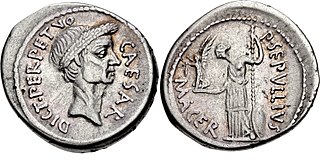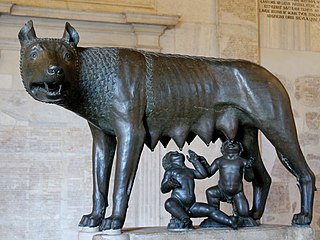
Aedile was an elected office of the Roman Republic. Based in Rome, the aediles were responsible for maintenance of public buildings and regulation of public festivals. They also had powers to enforce public order and duties to ensure the city of Rome was well supplied and its civil infrastructure well maintained, akin to modern local government.

The cursus honorum was the sequential order of public offices held by aspiring politicians in the Roman Republic and the early Roman Empire. It was designed for men of senatorial rank. The cursus honorum comprised a mixture of military and political administration posts; the ultimate prize for winning election to each "rung" in the sequence was to become one of the two consuls in a given year.
Fasces is a bound bundle of wooden rods, often but not always including an axe with its blade emerging. The fasces is an Italian symbol that had its origin in the Etruscan civilization and was passed on to ancient Rome, where it symbolized a Roman king's power to punish his subjects, and later, a magistrate's power and jurisdiction. The axe has its own separate and older origin. Initially associated with the labrys, the double-bitted axe originally from Crete, is one of the oldest symbols of Greek civilization.

Tribune was the title of various elected officials in ancient Rome. The two most important were the tribunes of the plebs and the military tribunes. For most of Roman history, a college of ten tribunes of the plebs acted as a check on the authority of the senate and the annual magistrates, holding the power of ius intercessionis to intervene on behalf of the plebeians, and veto unfavourable legislation. There were also military tribunes, who commanded portions of the Roman army, subordinate to higher magistrates, such as the consuls and praetors, promagistrates, and their legates. Various officers within the Roman army were also known as tribunes. The title was also used for several other positions and classes in the course of Roman history.

Praetor, also pretor, was the title granted by the government of ancient Rome to a man acting in one of two official capacities: (i) the commander of an army, and (ii) as an elected magistratus (magistrate), assigned to discharge various duties. The functions of the magistracy, the praetura (praetorship), are described by the adjective itself: the praetoria potestas, the praetorium imperium, and the praetorium ius, the legal precedents established by the praetores (praetors). Praetorium, as a substantive, denoted the location from which the praetor exercised his authority, either the headquarters of his castra, the courthouse (tribunal) of his judiciary, or the city hall of his provincial governorship. The minimum age for holding the praetorship was 39 during the Roman Republic, but it was later changed to 30 in the early Empire.

The pomerium or pomoerium was a religious boundary around the city of Rome and cities controlled by Rome. In legal terms, Rome existed only within its pomerium; everything beyond it was simply territory (ager) belonging to Rome.

A lictor was a Roman civil servant who was an attendant and bodyguard to a magistrate who held imperium. Roman records describe lictors as having existed since the Roman Kingdom, and may have originated with the Etruscans.

Various lists regarding the political institutions of ancient Rome are presented. Each entry in a list is a link to a separate article. Categories included are: constitutions (5), laws (5), and legislatures (7); state offices (28) and office holders ; political factions and social ranks (8). A political glossary (35) of similar construction follows.

In ancient Rome, a promagistrate was a person who was granted the power via prorogation to act in place of an ordinary magistrate in the field. This was normally pro consule or pro praetore, that is, in place of a consul or praetor, respectively. This was an expedient development, starting in 327 BC and becoming regular by 241 BC, that was meant to allow consuls and praetors to continue their activities in the field without disruption.

A Roman dictator was an extraordinary magistrate in the Roman Republic endowed with full authority to resolve some specific problem to which he had been assigned. He received the full powers of the state, subordinating the other magistrates, consuls included, for the specific purpose of resolving that issue, and that issue only, and then dispensing with those powers immediately.

The magister equitum, in English Master of the Horse or Master of the Cavalry, was a Roman magistrate appointed as lieutenant to a dictator. His nominal function was to serve as commander of the Roman cavalry in time of war, but just as a dictator could be nominated to respond to other crises, so the magister equitum could operate independently of the cavalry; like the dictator, the appointment of a magister equitum served both military and political purposes.

A curule seat is a design of a (usually) foldable and transportable chair noted for its uses in Ancient Rome and Europe through to the 20th century. Its status in early Rome as a symbol of political or military power carried over to other civilizations, as it was also used in this capacity by kings in Europe, Napoleon, and others.

The Curiate Assembly was the principal assembly that evolved in shape and form over the course of the Roman Kingdom until the Comitia Centuriata organized by Servius Tullius. During these first decades, the people of Rome were organized into thirty units called "Curiae". The Curiae were ethnic in nature, and thus were organized on the basis of the early Roman family, or, more specifically, on the basis of the thirty original patrician (aristocratic) clans. The Curiae formed an assembly for legislative, electoral, and judicial purposes. The Curiate Assembly passed laws, elected Consuls, and tried judicial cases. Consuls always presided over the assembly. While plebeians (commoners) could participate in this assembly, only the patricians could vote.

A Roman governor was an official either elected or appointed to be the chief administrator of Roman law throughout one or more of the many provinces constituting the Roman Empire.

A consul was the highest elected public official of the Roman Republic. Romans considered the consulship the second-highest level of the cursus honorum—an ascending sequence of public offices to which politicians aspired—after that of the censor, which was reserved for former consuls. Each year, the Centuriate Assembly elected two consuls to serve jointly for a one-year term. The consuls alternated each month holding fasces when both were in Rome. A consul's imperium extended over Rome and all its provinces.

The king of Rome was the ruler of the Roman Kingdom. According to legend, the first king of Rome was Romulus, who founded the city in 753 BC upon the Palatine Hill. Seven legendary kings are said to have ruled Rome until 509 BC, when the last king was overthrown. These kings ruled for an average of 35 years.

The Roman magistrates were elected officials in ancient Rome. During the period of the Roman Kingdom, the King of Rome was the principal executive magistrate. His power, in practice, was absolute. He was the chief priest, lawgiver, judge, and the sole commander of the army. When the king died, his power reverted to the Roman Senate, which then chose an Interrex to facilitate the election of a new king.

The constitution of the Roman Republic was a set of uncodified norms and customs which, together with various written laws, guided the procedural governance of the Roman Republic. The constitution emerged from that of the Roman kingdom, evolved substantively and significantly – almost to the point of unrecognisability – over the almost five hundred years of the republic. The collapse of republican government and norms beginning in 133 BC would lead to the rise of Augustus and his principate.

The Roman Constitution was an uncodified set of guidelines and principles passed down mainly through precedent. The Roman constitution was not formal or even official, largely unwritten and constantly evolving. Having those characteristics, it was therefore more like the British and United States common law system than a sovereign law system like the English Constitutions of Clarendon and Great Charter or the United States Constitution, even though the constitution's evolution through the years was often directed by passage of new laws and repeal of older ones.

The executive magistrates of the Roman Republic were officials of the ancient Roman Republic, elected by the People of Rome. Ordinary magistrates (magistratus) were divided into several ranks according to their role and the power they wielded: censors, consuls, praetors, curule aediles, and finally quaestor. Any magistrate could obstruct (veto) an action that was being taken by a magistrate with an equal or lower degree of magisterial powers. By definition, plebeian tribunes and plebeian aediles were technically not magistrates as they were elected only by the plebeians, but no ordinary magistrate could veto any of their actions. Dictator was an extraordinary magistrate normally elected in times of emergency for a short period. During this period, the dictator's power over the Roman government was absolute, as they were not checked by any institution or magistrate.





